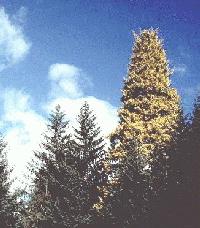CONIFEROPHYTA
Raven 7th, p. 413-427, 591-593
Raven 8th, p. 626 – 628
Introduction
The conifers are the largest extant group of the gymnosperms (meaning “naked seed”). Conifers can be traced back some 300 million years in the fossil record. Today there exist approximately 550 species which are distributed in the temperate zones of the northern and southern hemispheres. Many species are of great commercial value (for example, in the economy of British Columbia). This is a picture of the “Golden Spruce” which was illegally cut down recently in the Queen Charlotte Islands. It was a rare mutant which survived for three hundred some years.
The Coniferophyta (also known as the Pinophyta) are distinguished by several characteristics, none of which is unique to the group. However, the combination of the characteristics is unique.
Characteristics of the Conifers:
- produce conelike strobili which are of two kinds; seed and pollen cones.
- are heterosporous, producing megaspores within the seed (female) cone and microspores within the pollen (male) cone.
- the female gametophyte generation is very reduced and develops within the seed cone which is retained upon the sporophyte.
- the pollen grain is the male gametophyte.
- the seeds are ‘exposed’ (unlike the angiosperms, whose seeds are enclosed in an ovary).
- the primary vascular tissue of the stem is an endarch eustele (like the angiosperms).
- the wood of the conifers has tracheids and seive cells with albuminous cells (lacks vessels and sieve tube elements with companin cells).
In the following sections we will examine aspects of the conifers based primarily on Pinus species:

